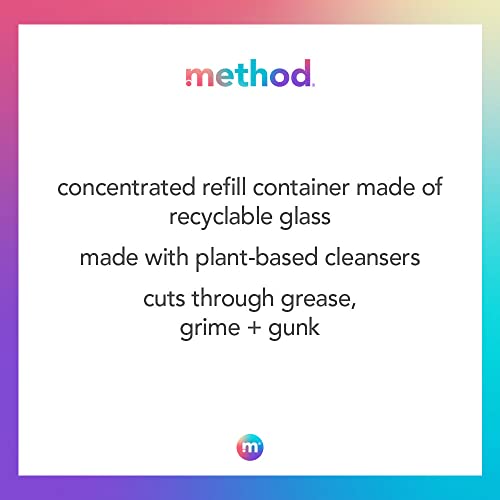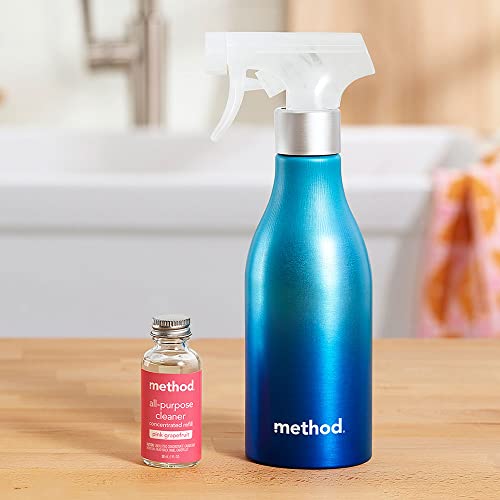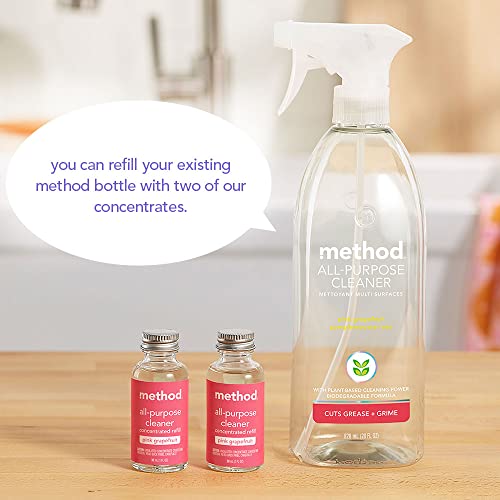






Method All-Purpose Cleaner - Plant-Based Grease Cutter, Cruelty-Free, Pink Grapefruit - 4 Refills


Potassium Hydroxide
High RiskPotassium hydroxide is a caustic inorganic base commonly used in various products for its ability to adjust pH levels and act as a cleaning agent. It is highly soluble in water and can produce heat upon dissolution, making it effective in certain formulations.
Sustai Insights
Potassium hydroxide serves as a strong pH adjuster and cleaning agent, but it poses significant health risks due to its caustic nature, which can cause irritation to skin and eyes. Environmental concerns include its potential to contribute to water pollution. Regulatory bodies have imposed strict usage restrictions due to these hazards, leading to a high-risk overall assessment. Safe handling practices are essential, and alternatives such as citric acid may provide safer pH adjustment without the associated risks.
Fragrance
High RiskFragrance refers to a mixture of aromatic compounds used in products to provide scent. It is commonly listed as 'fragrance' or 'parfum' on product labels and can serve various functions, including enhancing user experience and masking undesirable odors.
Sustai Insights
Fragrance offers functional benefits by improving product appeal; however, it poses significant health risks, notably a high likelihood of causing allergies and allergic contact dermatitis. Environmental risks include potential pollution and endocrine disruption, though its overall carcinogenicity is low. Regulatory bodies have noted concerns regarding its use, leading to a high-risk classification. Safe usage practices should be observed, and alternatives such as natural essential oils are recommended for those sensitive to synthetic fragrances.
Citric Acid
Medium RiskCitric acid is an alpha hydroxy acid used in personal care products primarily for its role as a pH adjuster and natural preservative. It occurs naturally in citrus fruits and is commonly utilized in various formulations for its chelating properties and mild exfoliation benefits.
Sustai Insights
Citric acid offers functional benefits as an effective preservative and pH stabilizer, contributing to product longevity and stability. It is biodegradable and derived from renewable sources. Health risks are low, with minimal concerns regarding carcinogenicity, allergies, and reproductive toxicity. However, moderate use restrictions exist due to potential irritation at high concentrations. Environmental risks are limited, as citric acid is not known to accumulate in ecosystems. Regulatory agencies have no significant advisories against its use. Overall, it is assessed as a medium-risk ingredient, with safe usage practices recommended and alternatives available.
Water
Low RiskWater is a clear, colorless liquid essential for various biological processes. It serves as a solvent in formulations, facilitating the dissolution of other ingredients and enhancing product texture and application. Additionally, water plays a crucial role in hydration and is a key component in many cosmetic and personal care products.
Sustai Insights
Water is an effective solvent and hydrator, contributing to the texture and efficacy of formulations. It is biodegradable and generally regarded as safe, with low concerns regarding carcinogenicity, allergies, and reproductive toxicity. However, excessive water usage can lead to environmental concerns, particularly regarding resource depletion. Regulatory bodies do not impose restrictions on water use in cosmetics. Overall, the risks associated with water are low, making it a safe and essential ingredient.
Sodium Citrate
Low RiskSodium citrate is used in cosmetic formulations primarily as a buffering agent, helping to stabilize pH levels. It is derived from citric acid and is commonly found in various personal care products to enhance their efficacy and stability.
Sustai Insights
Sodium citrate offers functional benefits such as effective pH regulation and acts as a mild preservative. It is generally recognized as safe with low risks for cancer, allergies, and reproductive toxicity. Environmental concerns are minimal, with no significant pollutant potential or bioaccumulation. Regulatory bodies like the FDA and COSMOS have no major restrictions on its use. Overall, sodium citrate presents a low risk, making it a viable ingredient in cosmetic formulations. Safe usage practices should be followed, and alternatives are not typically necessary.
Caprylyl/ Capryl Glycoside
Low RiskCaprylyl/Capryl Glycoside is a surfactant derived from natural sources, primarily used in personal care and cosmetic products for its emulsifying properties. It helps to stabilize formulations and enhance cleaning efficacy while being gentle on the skin.
Sustai Insights
Caprylyl/Capryl Glycoside offers functional benefits as a mild surfactant and emulsifier, contributing to product stability without significant irritation. It is biodegradable and considered sustainably sourced. Health risks are low, with minimal concerns regarding carcinogenicity and developmental toxicity. Environmental impact is also low, as it does not accumulate in ecosystems. Regulatory assessments indicate no current restrictions. Overall, it presents a low risk profile, making it a suitable choice in formulations.
Bornanedione
Low RiskBornanedione is an organic compound that serves various functions in products, primarily in the realm of fragrance and flavoring agents. Its use is regulated, and it is not currently listed among restricted substances in skin contact applications, suggesting a generally accepted safety profile.
Sustai Insights
Bornanedione offers functional benefits as a flavoring agent without significant health risks, including low concerns for carcinogenicity, allergenicity, and reproductive toxicity. Environmentally, it poses minimal risks, with no evidence of bioaccumulation or pollution. Regulatory bodies do not impose notable restrictions. Overall, the ingredient presents a low risk profile, making it a safe choice in formulations.
Caprylyl/ Capryl Glucoside
Low RiskCaprylyl/capryl glucoside is an alkyl glucoside derived from natural sources, commonly used as a surfactant and emulsifier in personal care products. It aids in the cleansing and foaming properties of formulations, enhancing the overall texture and performance without harsh effects.
Sustai Insights
Caprylyl/capryl glucoside serves effectively as a mild surfactant, providing gentle cleansing and emulsification. It is biodegradable and derived from renewable sources, contributing to its sustainability profile. However, it may cause mild skin irritation in sensitive individuals, and while its allergenic potential is low to moderate, caution is advised. Regulatory status indicates no significant restrictions, and overall risk assessment suggests a low risk for health and environmental impacts, making it a favorable option in formulations.
Water
Low RiskWater is a clear, colorless liquid essential for various biological processes. It serves as a solvent in formulations, facilitating the dissolution of other ingredients and enhancing product texture and application. Additionally, water plays a crucial role in hydration and is a key component in many cosmetic and personal care products.
Sustai Insights
Water is an effective solvent and hydrator, contributing to the texture and efficacy of formulations. It is biodegradable and generally regarded as safe, with low concerns regarding carcinogenicity, allergies, and reproductive toxicity. However, excessive water usage can lead to environmental concerns, particularly regarding resource depletion. Regulatory bodies do not impose restrictions on water use in cosmetics. Overall, the risks associated with water are low, making it a safe and essential ingredient.
Potassium Hydroxide
High RiskPotassium hydroxide is a caustic inorganic base commonly used in various products for its ability to adjust pH levels and act as a cleaning agent. It is highly soluble in water and can produce heat upon dissolution, making it effective in certain formulations.
Sustai Insights
Potassium hydroxide serves as a strong pH adjuster and cleaning agent, but it poses significant health risks due to its caustic nature, which can cause irritation to skin and eyes. Environmental concerns include its potential to contribute to water pollution. Regulatory bodies have imposed strict usage restrictions due to these hazards, leading to a high-risk overall assessment. Safe handling practices are essential, and alternatives such as citric acid may provide safer pH adjustment without the associated risks.
Sodium Citrate
Low RiskSodium citrate is used in cosmetic formulations primarily as a buffering agent, helping to stabilize pH levels. It is derived from citric acid and is commonly found in various personal care products to enhance their efficacy and stability.
Sustai Insights
Sodium citrate offers functional benefits such as effective pH regulation and acts as a mild preservative. It is generally recognized as safe with low risks for cancer, allergies, and reproductive toxicity. Environmental concerns are minimal, with no significant pollutant potential or bioaccumulation. Regulatory bodies like the FDA and COSMOS have no major restrictions on its use. Overall, sodium citrate presents a low risk, making it a viable ingredient in cosmetic formulations. Safe usage practices should be followed, and alternatives are not typically necessary.
Caprylyl/ Capryl Glycoside
Low RiskCaprylyl/Capryl Glycoside is a surfactant derived from natural sources, primarily used in personal care and cosmetic products for its emulsifying properties. It helps to stabilize formulations and enhance cleaning efficacy while being gentle on the skin.
Sustai Insights
Caprylyl/Capryl Glycoside offers functional benefits as a mild surfactant and emulsifier, contributing to product stability without significant irritation. It is biodegradable and considered sustainably sourced. Health risks are low, with minimal concerns regarding carcinogenicity and developmental toxicity. Environmental impact is also low, as it does not accumulate in ecosystems. Regulatory assessments indicate no current restrictions. Overall, it presents a low risk profile, making it a suitable choice in formulations.
Bornanedione
Low RiskBornanedione is an organic compound that serves various functions in products, primarily in the realm of fragrance and flavoring agents. Its use is regulated, and it is not currently listed among restricted substances in skin contact applications, suggesting a generally accepted safety profile.
Sustai Insights
Bornanedione offers functional benefits as a flavoring agent without significant health risks, including low concerns for carcinogenicity, allergenicity, and reproductive toxicity. Environmentally, it poses minimal risks, with no evidence of bioaccumulation or pollution. Regulatory bodies do not impose notable restrictions. Overall, the ingredient presents a low risk profile, making it a safe choice in formulations.
Fragrance
High RiskFragrance refers to a mixture of aromatic compounds used in products to provide scent. It is commonly listed as 'fragrance' or 'parfum' on product labels and can serve various functions, including enhancing user experience and masking undesirable odors.
Sustai Insights
Fragrance offers functional benefits by improving product appeal; however, it poses significant health risks, notably a high likelihood of causing allergies and allergic contact dermatitis. Environmental risks include potential pollution and endocrine disruption, though its overall carcinogenicity is low. Regulatory bodies have noted concerns regarding its use, leading to a high-risk classification. Safe usage practices should be observed, and alternatives such as natural essential oils are recommended for those sensitive to synthetic fragrances.
Caprylyl/ Capryl Glucoside
Low RiskCaprylyl/capryl glucoside is an alkyl glucoside derived from natural sources, commonly used as a surfactant and emulsifier in personal care products. It aids in the cleansing and foaming properties of formulations, enhancing the overall texture and performance without harsh effects.
Sustai Insights
Caprylyl/capryl glucoside serves effectively as a mild surfactant, providing gentle cleansing and emulsification. It is biodegradable and derived from renewable sources, contributing to its sustainability profile. However, it may cause mild skin irritation in sensitive individuals, and while its allergenic potential is low to moderate, caution is advised. Regulatory status indicates no significant restrictions, and overall risk assessment suggests a low risk for health and environmental impacts, making it a favorable option in formulations.
Citric Acid
Medium RiskCitric acid is an alpha hydroxy acid used in personal care products primarily for its role as a pH adjuster and natural preservative. It occurs naturally in citrus fruits and is commonly utilized in various formulations for its chelating properties and mild exfoliation benefits.
Sustai Insights
Citric acid offers functional benefits as an effective preservative and pH stabilizer, contributing to product longevity and stability. It is biodegradable and derived from renewable sources. Health risks are low, with minimal concerns regarding carcinogenicity, allergies, and reproductive toxicity. However, moderate use restrictions exist due to potential irritation at high concentrations. Environmental risks are limited, as citric acid is not known to accumulate in ecosystems. Regulatory agencies have no significant advisories against its use. Overall, it is assessed as a medium-risk ingredient, with safe usage practices recommended and alternatives available.
Transform your cleaning routine with Method All-Purpose Cleaner Concentrates in Pink Grapefruit. This eco-friendly solution combines plant-based ingredients with powerful cleaning capabilities, making it a smart choice for health-conscious consumers.
- Effective Cleaning: Cuts through grease and grime effortlessly, ensuring a sparkling clean without harsh chemicals.
- Eco-Conscious Design: Each pack contains four recyclable 1 fl oz refills, reducing plastic waste by over 96% compared to single-use bottles.
- Plant-Based Formula: Made with natural ingredients and free from parabens and phthalates, promoting a healthier home environment.
- Cruelty-Free Commitment: Never tested on animals, aligning with ethical consumer values.
- Simple to Use: Just mix with water in a reusable spray bottle for a powerful cleaning solution that's easy to prepare and store.
Choose Method for a cleaner home and a cleaner planet.
Subscribe & Save with Sustai
- Best Price Guarantee: Always enjoy the lowest prices on sustainable home essentials.
- No Surprises: We’ll notify you before shipping. No hidden fees, ever.
- You’re in Charge: Change, pause, or cancel your subscription anytime with ease.
- Eco-Friendly Deliveries: Our grouped shipments mean less packaging and lower emissions.
Join us on a sustainable journey. Special offers for a limited time! Prices and promotions may change.
Recommended Products
Transform your cleaning routine with Method All-Purpose Cleaner Concentrates in Pink Grapefruit. This eco-friendly solution combines plant-based ingredients with powerful cleaning capabilities, making it a smart choice for health-conscious consumers.
- Effective Cleaning: Cuts through grease and grime effortlessly, ensuring a sparkling clean without harsh chemicals.
- Eco-Conscious Design: Each pack contains four recyclable 1 fl oz refills, reducing plastic waste by over 96% compared to single-use bottles.
- Plant-Based Formula: Made with natural ingredients and free from parabens and phthalates, promoting a healthier home environment.
- Cruelty-Free Commitment: Never tested on animals, aligning with ethical consumer values.
- Simple to Use: Just mix with water in a reusable spray bottle for a powerful cleaning solution that's easy to prepare and store.
Choose Method for a cleaner home and a cleaner planet.

You can have at most 2 Sustainable Steals products in your cart
Customer Reviews
Customers’ View
Customers appreciate the effectiveness and eco-friendly nature of the All-Purpose Cleaner Concentrate Refills. Many users highlight the pleasant scent, describing it as 'wonderful' and 'clean without being overpowering.' The product is noted for its powerful cleaning capabilities, with users reporting that it effectively tackles grease and stains with ease. Additionally, the recyclable glass refills resonate well with environmentally conscious consumers, who value the reduction of plastic waste. However, some customers express concerns about the product's cost-effectiveness, feeling that it may not be the best value for their money. Overall, the cleaner aligns well with sustainable practices while delivering satisfactory cleaning performance.
AI-generated from the text of customer reviewsThis product is rated 4.6 of 5.0 stars.
It has received 5 reviews.




